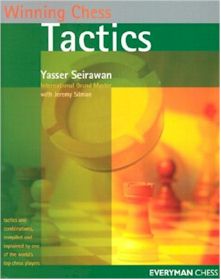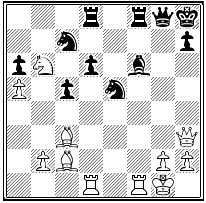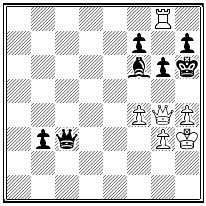Winning Chess Tactics 
 An Easytorecall Book Review
An Easytorecall Book Review
Winning Chess: Tactics
By GM Yasser Seirawan with Jeremy Silman Everyman Publishers 2003 £14.99
Book Review
by Graham Brown
IN the first book of the "Winning Chess" series. (See review) Seirawan introduced the basic rules and strategy of the game. In doing this, tactics were largely put to one side to give the pupil an overview and a feel of how and when tactics arise. Now in book 2 it is time for a detailed look at tactics.
Seirawan begins by saying that most tactics books don't really give deep explainations, with the rare exceptions being those for advanced players. As we have seen in book 1, Seirawan is not one for having low expectations of his readers. But again he takes great care to build from simple clearly written explainations. This means that he can pursue his stated goal to "enlighten beginner and tournament player alike." The beginner is encouraged to look up every word they don't understand, and then the glossary provides detailed ex- plainations. The answers to the quizzes are also extensive.
Tactics and combinations are tricky. Unlike in chess problems where it is "Checkmate in 3" there are no written warnings at the chessboard when a tactic or stunning combination is on. So Seirawan starts with some rules of recognition.
The first one is "The double attack" based on Averbakh's rule of recognition that almost all combinations are based on a double attack of some kind. Seirawan says that he didn't want to agree with such a simplified view at first, but the more he thought about it, the more sensible it seemed.
Then he lists Silman's Rules of Recognition, (This is Jeremy Silman who is the co-author of this book). Silman insists that combinations cannot exist without one or more of the following present:
- A weakened king
- Stalemated king
- Undefended pieces (not pawns).
- Inadequately guarded pieces.
I tested these rules on a couple of Quiz Today questions chosen on a whim. Let's choose CT-700 as it's a round number, which had the following 2 positions.
B Roselli - O Korneev
Sao Paulo Sao Paulo (5), 2002

Black to play
Applying Silman's rules, 1. The king looks rather weak there, 2 The King is stalemated. There are no Undefended pieces (not pawns), but assuming that 4. Inadequately guarded pieces doesn't say (not pawns) after it then that g2 pawn is not very well defended and indeed is part of the solution.
V Mikhalevski - A Cajal
Sao Paulo Sao Paulo (2), 2002

White to play
Applying Silman's rules, 1. The king looks rather weak there, 3. There is an undefended piece. 4. There are inadequately guarded pieces. (Answers at end of review)
The point where "Don't kid yourself, you've done nothing to deserve them, no tactics are on, don't waste your time looking" becomes "White to play and win brilliantly" is obviously not always easy to spot. But I should imagine that is something that can quite easily be improved with practice.
After this introduction we arrive at the main part of the book where tactics are divided into themes.
Firstly we look at The Double Attack. Three types are looked at, discovered attacks, forks and attacks by a pawn. Seirawan uses simple test positions to explain each theme and then often the position is changed slightly to see how the change affects the result. This is very useful in understanding each theme and also can help to move from a simplified version of a tactic to a more complex one: the first providing the clues to the second more complex position.
All the various tactical themes are introduced one by one all with very clear explainations and tests. These tests are sometimes from live games including Seirawan's own games. We get a paragraph about when the game was played and some clue as to what we are looking for. In all of them we are asked questions about the position in such a way that we are led into understanding a theme step by step.
Part 2 is "Great Tacticians and their Games". From Anderssen to Kasparov we are introduced to some of the greatest tacticians of all time. For each there is an short interesting biography and then games. I especially like one Kasparov game where Seirawan says "you don't want your King running around in the center against Kasparov". One suspects Silman's rules are spotted eagerly and early by the Number 1 graded player.
Part 3 has more tests and solutions presented with no indication of what type they are. This provides a good test for the reader. The answers are detailed and helpful.
There are some challenging positions, I especially liked this one when I had looked up the solution.
Tactical Test from
Winning Chess Tactics 2003

White to play
As I mentioned in the introduction, the first book in this series rather cleverly taught advanced strategic concepts before tactics. This was not a denegration of tactics but just a particular way of ordering the teaching of the elements of chess.
The stage was set for this book to teach pure tactics.
In the first book, Seiraway showed great creativity in his method of teaching. This book required a different more "chalk and talk" type teaching style. Seirawan has come up with the goods in a systematic, clear, interesting and fun way.
Answers:
51...g5! 52.Qb4 52.fxg5 f4# 52...gxf4+ 53.Kd2 Qxg2+ 0–1
30.Rxf6!
30.. Rxf6 31.Bxe5 dxe5 32.Rxd8 Qxd8 33.Qxh7# 1–0
1.Qg5+ Bxg5 2.hxg5+ Kh5 3.Rh8 3...Qxh8 4.g4#
This review was first published in Chess Today CT-929.
Graham Brown is a Freelance Journalist, technical editor of Chess Today and co-author of the Batsford book Chess on the Web
Can't find it?
Try our search engines, price comparison and online auction pages.

